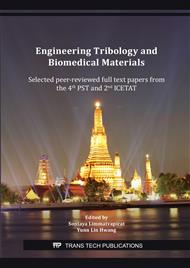[1]
G. Feketea, S. Tsabouri, Common food colorants and allergic reactions in children: Myth or reality?, Food Chem. 230 (2017) 578-588.
DOI: 10.1016/j.foodchem.2017.03.043
Google Scholar
[2]
R.D. Combes, R.B. Haveland-Smith, A review of the genotoxicity of food, drug and cosmetic colours and other azo, triphenylmethane and xanthene dyes, Mutat. Res-Rev. Genet. 98 (1982) 101-243.
DOI: 10.1016/0165-1110(82)90015-x
Google Scholar
[3]
C.D. Lucas, J.B. Hallagan, S.L. Taylor, The role of natural color additives in food allergy, Adv. Food. Nutr. Res. 43 (2001) 195-216.
DOI: 10.1016/s1043-4526(01)43005-1
Google Scholar
[4]
J.F. Morton, Notes on distribution, propagation, and products of Borassus palms (Arecaceae), Econ. Bot. 42 (1988) 420-441.
DOI: 10.1007/bf02860166
Google Scholar
[5]
E. Jansz, N. Wickramasekera, K. Sumuduni, A review of the chemistry and biochemistry of seed shoot flour and fruit pulp of the palmyrah palm (Borassus flabellifer L), J. Natl. Sci. Found. 30 (2010) 61-87.
DOI: 10.4038/jnsfsr.v30i1-2.2562
Google Scholar
[6]
S. Artnarong, M. Payap, M. Jaruwan, Preparation the substrate from palmyra palm fruit by Candida stellimalicola fermentation for acetic acid production, Asia. Pac. J. Sci. Technol. 21 (2016) 397-403.
Google Scholar
[7]
M. Alamelumangai, D. Jothi, M. Mathumitha, R. Renganayaki, P. Muthukumaran, S. Nachimuthu, In vitro studies on phytochemical evaluation and antimicrobial activity of Borassus flabellifer Linn. against some human pathogens, Asian Pac. J. Trop. Med. 7(Suppl 1) (2014) S182-5.
DOI: 10.1016/s1995-7645(14)60228-5
Google Scholar
[8]
K. Renuka, V. Devi, S. Subramanian, Phytochemical screening and evaluation of in vitro antioxidant potential of immature palmyra palm (Borassus flabellifer Linn.) fruits, Int. J. Pharm. Pharm. Sci. 10 (2018) 77.
DOI: 10.22159/ijpps.2018v10i8.27162
Google Scholar
[9]
M.H. Rodiah, B. Jamilah, S.M. Sharifah Kharidah, A.R. Russly, Physico-chemical and antioxidant properties of mesocarp and exocarp from Borassus flabellifer, Int. Food Res. J. 26 (2019) 8.
Google Scholar
[10]
A. Barfod, J. Dransfield, Arecaceae, Flora of Thailnd, Vol.11(3), Prachachon CO. LTD., Bangkok, 2013. 323-498.
Google Scholar
[11]
L.M.J. de Carvalho, P.B. Gomes, R.L.d.O. Godoy, S. Pacheco, P.H.F. do Monte, J.L.V. de Carvalho, M.R. Nutti, A.C.L. Neves, A.C.R.A. Vieira, S.R.R. Ramos, Total carotenoid content, α-carotene and β-carotene, of landrace pumpkins (Cucurbita moschata Duch): A preliminary study, Food Res. Int. 47 (2012) 337-340.
DOI: 10.1016/j.foodres.2011.07.040
Google Scholar
[12]
S. Yadav,R. Prabha, Effect of pH and Temperature on Carotenoid Pigments produced from Rhodotorula Minuta, Int. J. Fermented Foods. 3 (2014) 105.
DOI: 10.5958/2321-712x.2014.01312.x
Google Scholar
[13]
A. Petchsomrit, M.I. McDermott, S. Chanroj, W. Choksawangkarn, Watermelon seeds and peels: fatty acid composition and cosmeceutical potential, OCL. 27 (2020) 54.
DOI: 10.1051/ocl/2020051
Google Scholar
[14]
L. Zeng, Y. Liu, J. Pan, X. Liu, Formulation and evaluation of norcanthridin nanoemulsions against the Plutella xylostella (Lepidotera: Plutellidae), BMC Biotechnol. 19 (2019) 16.
DOI: 10.1186/s12896-019-0508-8
Google Scholar
[15]
I.M. Abu Zeid A.R.A. FarajAlla, Borassus flabellifer L. Palmyra Palm (Daleeb): Biochemistry, Functions and Utilization, in Wild Fruits: Composition, Nutritional Value and Products, A.A. Mariod, Editor. 2019, Springer International Publishing: Cham. pp.465-479.
DOI: 10.1007/978-3-030-31885-7_35
Google Scholar
[16]
K.G. Fandi, F.H. Shah, H.M. Ghazali, Protein profiling during mesocarp development in oil palm fruit, Pertanika J. Trop. Agric. Sci. 34 (2011) 63-73.
Google Scholar
[17]
A. Kurian, G. Thiripuranathar, P.A. Paranagama, Determination of total phenolic content and antioxidant activity of Borassus flabeliffer Linn. fruit pulp collected from several parts of Sri Lanka, IJPSR. 8 (2017) 2701-2705.
Google Scholar
[18]
C.S. Boon, D.J. McClements, J. Weiss, E.A. Decker, Factors influencing the chemical stability of carotenoids in foods, Crit. Rev. Food Sci. Nutr. 50 (2010) 515-532.
DOI: 10.1080/10408390802565889
Google Scholar
[19]
C. Marty,C. Berset, Factors affecting the thermal degradation of all-trans-.beta.-carotene, J. Agric. Food Chem. 38 (1990) 1063-1067.
DOI: 10.1021/jf00094a033
Google Scholar


